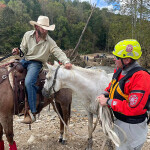Every horse owner encounters it: your horse sustains a laceration. These injuries can occur anywhere on the body and at any time, ranging from minor to life-threatening. If not promptly treated, serious infections can develop, and the treatment plan may become more expensive. Moreover, horse owners can take preventive measures to minimize the risk of their horse(s) suffering a laceration.
Laceration 101
A laceration is a wound that occurs when soft tissue, typically layers of the epidermis, is torn in a jagged or irregular manner, often caused by blunt or sharp objects. Lacerations can appear anywhere on a horse’s body, with the legs and head being the most common sites. Regardless of the location, all lacerations should be taken seriously and treated promptly with first aid, followed by a consultation with your veterinarian. The severity of a laceration depends on several factors:
- Location, particularly if it involves a synovial structure such as a joint, tendon sheath, or bursa.
- Amount of hemorrhage (bleeding).
- Rate of hemorrhage (how quickly blood is flowing from the wound).
Another challenge in managing equine lacerations is determining the time of injury. Horses are not typically supervised around the clock, making it difficult to pinpoint when the laceration occurred. This is crucial because there is a limited window—usually 6 to 8 hours—during which sutures can be applied to minimize infection and promote healing. If a laceration is found to have occurred beyond this timeframe, your veterinarian might opt to wait a few days until the wound bed is healthy enough to hold sutures.
Laceration Treatment
All barns and horse owners should have a clear protocol for handling laceration injuries in horses. It’s crucial to have multiple first aid kits and supplies readily accessible, as prompt action is essential. The key steps are to remain calm and immediately call for veterinary assistance. Avoid treating the laceration alone if possible; enlist someone to help manage the horse until the veterinarian arrives.
If the horse sustains a laceration while out on pasture, bring it to a clean area near a water spigot or hose. Document the injury with photos to send to your veterinarian during the initial treatment. Once the horse is secured, there are several management steps you can take to address the laceration while awaiting professional help.
- If your horse allows you to touch the wound, start by removing any debris and contaminants. You can use tap water for washing or flushing the area. Ideally, sterile saline with or without Betadine or chlorhexidine solution should be used, but many horse owners opt for a garden hose. When using antiseptic solutions, always dilute them to prevent tissue damage. Mix 20-25 mL of chlorhexidine or 10 mL of Betadine per quart of water. Avoid using hydrogen peroxide.
- If your horse does not let you touch the wound, consult your veterinarian over the phone about restraining methods. Remember, your safety is paramount!
- Once the contaminants are removed, clean the wound with antiseptic soap (chlorhexidine or povidone iodine). Rinse thoroughly to prevent skin irritation.
- Allow the wound to air dry while you prepare your bandaging materials.
- While talking to your veterinarian, ask about applying antibiotic ointments before bandaging. Most likely, the veterinarian will advise against it for better wound visualization or if the wound is bleeding continuously, it might be counterproductive.
- Apply direct pressure to reduce bleeding to a safe level. This can be done with gauze (e.g., 4x4 square gauze).
- Apply bandaging materials (typically a thick cotton roll, brown gauze, vet wrap, and elastic gauze) to maintain pressure until the veterinarian arrives.
- If your horse bleeds through the bandage, do not remove it! Add additional bandage materials to maintain direct pressure.
Upon the veterinarian’s arrival, they will assess the laceration to determine if sutures are necessary. Typically, sutures remain for approximately 10-14 days. During this period, your horse will require daily or every-other-day bandage changes, along with antibiotics and topical ointments. It is crucial to keep the horse on stall rest to prevent the bandages from coming undone and to minimize exposure to contaminants at the suture site. Always change the bandage on a clean surface to ensure optimal healing.
Laceration Conclusion
Lacerations come in various shapes and sizes, and treating a leg laceration differs significantly from treating a head laceration. Every horse owner should possess the skill to administer first aid for lacerations immediately after an injury occurs. Prompt application of first aid can significantly improve laceration healing outcomes. If you have any questions about equine lacerations and their treatment, please consult your veterinarian or contact your local Extension office. Shelby County, TN residents can reach the UT TSU Shelby County Extension office at 901-752-1207 during normal business hours, Monday to Friday, 8:30 am to 4:30 pm CST.










